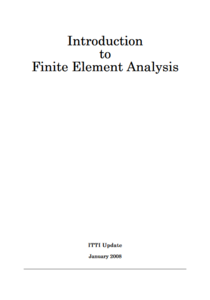| Contents | ii |
| Acknowledgements | iv |
| Notation | v |
| 1 Introduction | 1 |
| 1.1 What is finite element analysis (FEA)? | 1 |
| 1.2 The User's View | 1 |
| 1.2.1 Pre-processing | 3 |
| 1.2.2 Analysis | 4 |
| 1.2.3 Post-processing | 4 |
| 1.3 The FE Developer's View | 5 |
| 2 The Ideas of FEA | 6 |
| 2.1 The Engineering Approach | 6 |
| 2.2 The Principles of Virtual Displacement and Minimum Potential Energy | 11 |
| 2.3 Shape Functions | 13 |
| 2.4 Relationship between displacement and strain | 16 |
| 2.5 Use of the principle of virtual displacements | 18 |
| 2.6 Use of the Principle of Minimum Potential Energy | 20 |
| 3 Variational and Weighted Residual Methods | 22 |
| 3.1 Introduction | 22 |
| 3.2 Governing equations for physical problems | 22 |
| 3.3 Variational Methods | 24 |
| 3.3.1 Numerical Solution of Variational Problems: the Rayleigh-Ritz Method | 27 |
| 3.3.2 The Finite-Element Modification of the Rayleigh-Ritz Method | 31 |
| 3.3.3 Natural coordinates and quadratic shape functions | 38 |
| 3.4 The Weighted Residual Method | 41 |
| 3.5 Extension to Two and Three Dimensions | 46 |
| 3.5.1 Three-noded element for thermal conduction | 48 |
| 4 References | 52 |
| Appendix 1: Review of Matrix Algebra | 53 |
| Appendix 2: Isotropic Elasticity | 59 |
| Appendix 3: Shape Functions | 68 |
| Appendix 4: Rotation of axes & Isoparametric elements | 78 |



